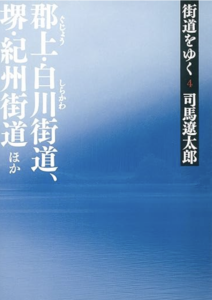Life Tips & Miscellaneous Travel and History Zen Philosophy and History Art and Sport Navigation of this blog
Summary
Travel is an act for human beings to visit new places and experience different cultures and histories. Through travel, people can actually feel historical events and people’s lives by visiting historical places and cultural heritage sites, and can gain a deeper understanding of history and broaden their own perspectives. In this section, we will discuss the historical background of the trip and the places visited based on Ryotaro Shiba’s “Kaido yuku” (On the Road) about this journey and history.

Kaidou wo yuku Vol 4 Tanba Sasayama kaidou.
In the previous article, we discussed the Gujo/Shirakawa Highway and the Etchu Highway. This time, we will discuss the Tanba-Sasayama Highway.
Tamba-Sasayama Highway
This trip is a route from Kyoto to Osaka and Hyogo, starting from Nagaoka-kyo, which was temporarily built when Nara was moved to Kyoto, and Oharano Shrine, which was established there by the Fujiwara clan. The road goes through Ronosaka to Kameyama Castle, built by Mitsuhide Akechi, Tamba Sasayama Castle, then south to Tachigui, where Tamba pottery studios gather, and then through Sanda to Arima Onsen, located at the upper Kobe area.

The Nagaoka-kyo Capital was relocated from Heijo-kyo in Nara by Emperor Kanmu in 784, and served as the capital for 10 years until 794, when it was moved to Heian-kyo (present-day Kyoto). Various excavations had been conducted by the time Ryotaro Shiba visited the area around 1970, and the area can be visited by taking the JR Kyoto Line and getting off at Nagaokakyo Station. Unlike Kyoto, Nagaokakyo functioned as the capital for only 10 years, and today there are no traces of it left, and it has become a bedroom community for the rural areas.

The Oharano Shrine in Nagaoka was built by the powerful Fujiwara clan as the clan deity of their family, and although the shrine pavilion is small, it is decorated in vermilion, and everything, including the woods and pond on the grounds, is sculpted in the “kokin” and “shinkokin” aesthetic, creating a beautiful shrine in the style of the imperial court.

From Oharano Shrine, we took a car and headed for Tamba Province (Hyogo Prefecture). On the way to the shrine, you will pass by Ro-no-zaka, the road along which Mitsuhide Akechi, who was in Kameyama at the time, went to Honnoji Temple in 1582 to kill Nobunaga Oda.

From that Ro-no-zaka, we head for the ruins of Tamba Kameyama Castle, built by Mitsuhide Akechi. The castle remained here until modern times.

In the Taisho era (1912-1926), a new religion, Omoto-kyo (Oyasama Oyasaburo Deguchi) purchased the site and built a temple there, but the Japanese government of the time thoroughly suppressed the temple, and it was blown up and destroyed. After the war, the Oomoto-kyo religion was restored and is said to have set up its headquarters again at the ruins of Kameyama Castle.
From the ruins of Kameyama Castle, the group moved to Tamba Sasayama. Tamba Sasayama is famous for “Tamba Fog,” a morning mist that rolls over the mountains of Tamba, and when you stand on a hill, the mist swirls through the valleys and peaks here and there look like islands floating in the sea.

Tamba is also one of the six oldest kilns in Japan (Seto, Tokoname, Echizen, Shigaraki, Bizen, and Tamba ware). Ryotaro Shiba and his group visited one of these kilns, Tamba Tachikake. Tamba Tachikake is one of the rare kilns in Japan that was established and has existed as a peasant kiln, not a government kiln established by a clan or the national government. Therefore, instead of being oriented to the idea that “if you make this type of pottery, you will be praised by the world’s high-class appreciators,” the pottery is solely for the demand of farmers, and is made into jars for storing seeds and jars for making o-haguro, jars for making sansho (Japanese pepper), tokuguri and other miscellaneous vessels. In recent years, various types of vessels have been made, but the ones that have been made in the past were those with the following earthy aroma.

Until the Edo period, Tamba ware had been mainly for practical use, but in the early Edo period, a tea master from Kyoto noticed this remote kiln, and after he put in some good knowledge that tea utensils could also be fired, the pieces he produced still remain as masterpieces of Ko-Tamba. In the early Showa period (1926-1989), folk art activists such as Muneyoshi Yanagi rediscovered the tea ceremony utensils and made them famous, but until the end of World War II, the village people of Tachikumi carried the pots on their backs to Osaka and Kyoto to sell them.
The group traveled south from Tanba Sasayama and ended their highway trip when they arrived at Sanda/Arima.

Arima Onsen is located in the mountains beyond the mountains from Kobe, and is one of the three oldest hot springs in Japan, along with Dogo Onsen in Ehime and Shirahama Onsen in Wakayama.
In the next article, we will discuss the Hokkoku Kaido and its side roads.


コメント